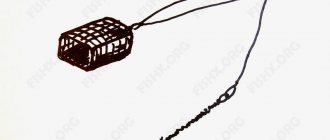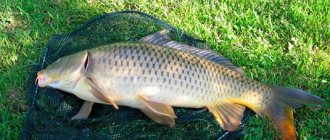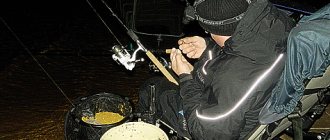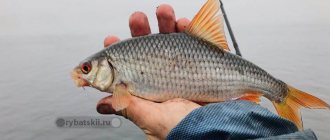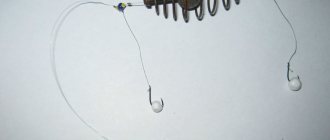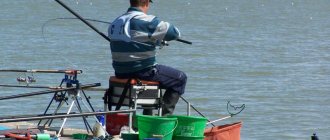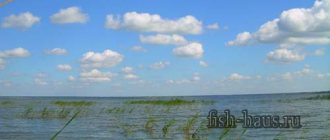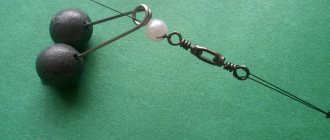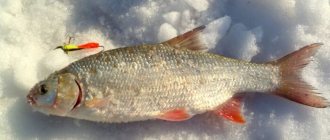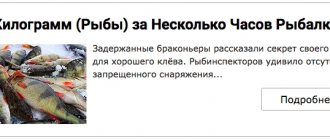Winter feeder fishing is gaining popularity among fishermen. This is not surprising, because with its help you can achieve a good catch. Moreover The device is simple and allows the fisherman not to spend money on buying a feeder in a store, but to make it himself. In this article we will talk about how to make a winter feeder with your own hands, what equipment and bait is needed for it, and we will describe the principles of fishing with it.
Feeder in winter
Fishing with an ice feeder is especially successful in reservoirs with constant or variable currents. Classic stationary feeders are of little use in this case, and the behavior of fish on a river is always characterized by its increased mobility compared to reservoirs or lakes.
Note! The main thing that distinguishes a winter feeder from a summer fishing rod is the sensitive tip. Of course, the size of the rod is also different, shorter. In combination with additional requirements for fishing rod equipment and special winter bait, an ice feeder can give good results.
The fact is that to fish with stationary feeders, the fisherman has to drill several holes: for feeders - upstream, and for fishing rods - downstream. When fishing with a winter feeder from the ice, one hole is enough. Reels are used of a small inertia-free type with a tuned clutch.
The main elements of equipment for winter feeder fishing:
- a short rod on which a reel is attached;
- whip 15−20 cm long;
- support for placing a fishing rod on ice;
- brightly colored nod;
- fishing line with a leash at the end;
- small hook;
One or two feeders, the weight of which will not allow them to be used not only in still water, but also in currents.
All of the above is a repetition of the summer version of the feeder tackle in the winter version, but without a rod equipped with rings. An under-ice feeder is used in cases where classic winter gear does not give the desired result.
Fishing with a feeder is convenient and enjoyable; no other fishing rods will be needed, they will simply remain to the side. A long and bright whip signals a bite, and fishing with a reel is more convenient than fiddling with the line with your hands.
When an angler is confident in the operation of the clutch, he can easily fish a trophy of any size out of the water. Even for those who come to ice fishing for the first time, this tackle will only bring pleasure.
Sub-ice feeder gear
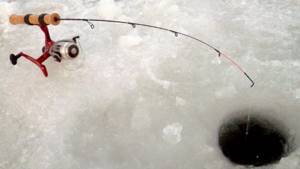
Winter feeder gear for ice fishing includes the following elements:
- Winter fishing rod with built-in or mounted reel;
- A whip made according to the feeder principle or with a guard;
- The supply of main monofilament line on a reel with a diameter of 0.14 - 0.22 mm, depending on the weight of the feeder and the size of the fish;
- Leashes with thin sharp hooks on a fishing line with a diameter 0.02 - 0.04 mm thinner than the main one;
- Feeder with the weight necessary to hold the equipment in the current.
A winter fishing rod for an ice feeder can be the same as when fishing with a float rig or made in the “European style” - a spinning-type reel and a fishing rod with a feeder tip and rings, allowing you to reel in the tackle and bring out the fish not with your hands, but directly with the fishing rod itself involving the coil clutch.
How to make a winter feeder
Anyone who has decided to make an under-ice feeder with their own hands can first view various models of this equipment on fishing websites. The main types of gear used in the feeder are a reel and fishing line with hooks.
Small and cautious fish will not bite on coarse tackle, but too thin tackle often lets you down.
It is necessary to make gear that will be equally good on lakes and on the river. A long fishing rod, convenient in summer, is not used. To properly equip the feeder, short winter fishing rods with whips at the end are more suitable.
To catch small fish, it is important to use a sensitive flexible whip, but the tip for pike perch with feeder tackle only works well if it is quite rigid and elastic.
fishing line
The main diameter of the fishing line, which is used when installing on an under-ice feeder: 0.16 mm. For catching bream it is a bit thin, in this case you can only use it as a short leash on the hook. To catch small and cautious fish, you will need a thinner fishing line, 0.12 mm or thinner, but you need to pay attention to its quality when purchasing.
When using feeder ice fishing, it is better to use soft types of fishing line that resist abrasion well. Most often, a monofilament thread made of nylon with a maximum thickness of 0.18 mm is taken. It can also be used for a leash, but with a thickness of no more than 0.12 mm.
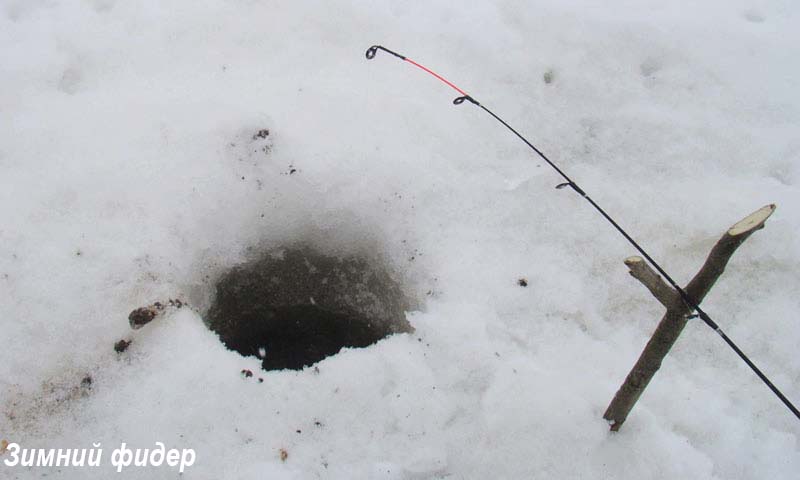
An excellent line option for catching small specimens is Team Salmo Micron. Winter fishing for pike requires a special leash at the end of the fishing line, which is made of metal wire or based on strong monofilament. In addition, you need live bait for pike.
Rod
It’s hardly worth buying a special fishing rod for winter fishing; making one with your own hands is very simple. Many old winter fishing rods with the shortest length are suitable for this. It is important that the rod has a good reel holder and a comfortable handle that does not freeze in the cold and does not slip in the hand.
Sometimes fishermen equip rods for winter feeders with special legs on which they can conveniently install the tackle above the hole. Others simply use pieces of ice to build a small slide with a depression in the middle, which is also an excellent support for a short fishing rod and reel.
Feeder
When ice fishing on a feeder, you should not use large summer feeders. With their excessive size, they can scare away cautious fish; moreover, the consumption of bait in winter is much less than in summer. During ice fishing, it is easier to achieve overfeeding. The baskets at the feeders should be small, otherwise the fish, having had enough, will lose all interest in the bait on the hook.
Small feeders are quite suitable, the weight of which ranges from 15 to 40 grams. If large summer feeders are used when fishing on a winter feeder, then their baskets can be cut in half, due to which the bait load lowered into the hole will be significantly reduced.
A little secret! Experienced fishermen prefer plastic feeders that have small holes or no holes at all. It is easy to stuff food into them with your fingers, and the washing out of the bait by the current occurs very slowly.
Currently, the winter feeder is very popular, industrialists quickly took note of this fact and began to produce enough small-sized feeders, from which you can always choose the best option.
Pros and cons of a winter feeder
The advantages of an under-ice feeder include:
- Due to the fact that the winter feeder rod essentially consists of a handle and a soft quiver tip. “Knits” fish very when playing. Suppresses the jerks of large fish , such as bream.
- The presence of an inertia-free or multiplier reel. Firstly, the additional help of the friction brake when landing good fish. And secondly, laying the fishing line on the spool , and not on the ice surface. Which is much more convenient in practice.
Disadvantages of a winter feeder that you definitely need to know:
- First and most important. At low temperatures from -5 and below, the upper ring freezes . The ice appears very quickly, which interferes with working with the reel. This can be solved by relatively warm weather or the presence of a heated tent. You can, of course, constantly clean it with your hand, but this depends on the fisherman’s readiness for difficulties.
- When there is standing water in the fishing area. Classic feeder installations are often confused . During the current there is no such problem.
After you have weighed all the pros and cons, it’s time to move on to rigging the rod.
Suitable accessories
It is much easier to prepare for fishing with an ice feeder if you use an arsenal of summer fishing gear when making it. The main equipment of the ice feeder is the same fishing line, reel and hooks that were purchased for summer fishing. With this fishing method, there is no need to buy any fancy jigs or synthetic baits.
Of course, you shouldn’t install a large reel on a small fishing rod, since in this case the entire balancing of the tackle will be disrupted, and the fisherman will lose the feeling of confidence and dexterity at critical moments of fishing. The best option would be a small but reliable reel, which was used in the summer for small fish. The main thing is that the friction is adjusted well and there is no looseness or play in the handle and spool device.
Winter ice feeder equipment
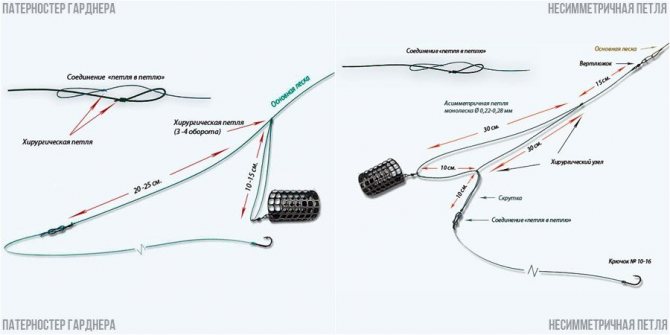
Equipment for a winter feeder can be mounted by analogy with any feeder equipment. Two types of feeder installation are most often used:
- Asymmetrical loop;
- Gardner's paternoster.
An asymmetrical loop is a little more difficult to knit than a paternoster, but more sensitive. It is preferable when fishing for small fish and in weak currents or in its absence. The Gardner loop is easier to install and knits much faster.
Considering that the winter feeder is a lighter version of the summer one, all elements of the winter equipment should be more delicate, and the loops and leashes should be somewhat shorter. Feeder installation methods are shown below.
Asymmetrical loop
Paternoster. Gardner's loop
Winter feeder
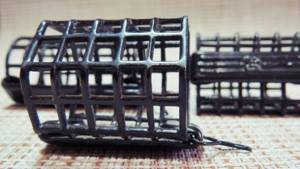
The feeder for the winter ice feeder is lighter and more compact than the summer feeder. Even in the presence of a current, the length of the fishing line on which it presses is much shorter, and its diameter is thinner - which means less load. In winter, much less bait is used, so the volume of the feeder is less capacious.
Lures
Fishing in winter is carried out with the same bait as in summer, but preference in ice fishing should still be given to animal bait - in cold water it is hardly possible to catch fish with bread or something of plant origin.
The most common baits for ice fishing on a feeder are:
- worms;
- maggots;
- bloodworm;
- corn kernels;
- dough balls.
For particularly fastidious inhabitants of the reservoir, you can use sandwiches made from worms and maggots, between which there is a bloodworm on the hook. It is worth completely abandoning combinations of baits, baits that combine food of animal and vegetarian origin. This does not give any tangible result; it is not worth wasting even time on the test.
What is the difference between a winter feeder and a summer feeder?
The technology for using feeder (bottom gear) in winter is the same as in summer. The only difficulty is waiting for bites, since the fish are not as active as in summer. Fish eat in winter, but less, so it is much more difficult to interest it and awaken its appetite. Otherwise, the approach remains the same: searching for a promising place, baiting the fishing point and catching fish using feeder equipment. Feeder equipment certainly consists of a feeder, which will have to be frequently loaded with bait. This is where the whole difficulty lies, since you will have to come into contact with water. Moreover, it is inconvenient to add bait to the feeder while wearing gloves, so you will have to use your bare hands. In such cases, you should take a towel with you that can quickly absorb moisture.
Excellent fishing on the feeder in winter (fishing story) [salapinru]
Igor 03/08/2017
Lure
When using an ice feeder, two types of bait are used: porridge and dry mixtures. Dry mixtures are prepared right at the fishing spot, and porridges are cooked in advance. When diluting dry mixtures, it is recommended to take water directly from the reservoir. After everything is thoroughly mixed, the food supply is kept in the bosom, where it will remain warm and soft.
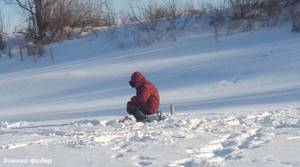
To prepare a good porridge, you should take millet cereal as a basis with the addition of flavorings and taste enzymes. For each fish during winter fishing, there are known compositions of suitable baits, which can be found on fishing websites.
Fishing with a feeder from ice
The concept of an under-ice feeder appeared in the everyday life of bottom fishermen not so long ago, after they tried to use an ice feeder to catch white fish in holes. In such a situation, the advantages of a feeder form when casting equipment are irrelevant, so they use a “mini” feeder equipped with a small spinning reel.
When fishing with standard winter fishing rods at a considerable depth, inconvenience arises when landing the fish, especially if after the bite it has already reeled off a few more meters of line. Delicate fishing with a mini feeder reel brings a lot of pleasure to the angler, and allows you to catch even large carp or silver carp.
Most often, when fishing on an ice feeder, the main target is bream or crucian carp, but catching carp is quite possible, and it is better to catch such fish with reliable tackle. In such cases, all the advantages of the feeder are fully demonstrated, and the angler copes with fish of any size.
Making an under-ice feeder with your own hands is not that difficult, and its main element is the quivertip, which is sensitive to bites from fish of any size.
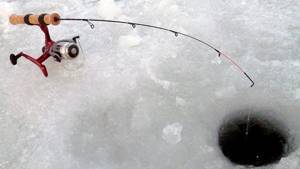
But the range of fishing products from well-known manufacturers now includes winter feeders for ice fishing, which show excellent results. As an example, let's take Ice Feeder from Salmo. The advantages of an ice feeder appear when fishing in a reservoir with an uneven current and great depth, in conditions where it is impossible to use standard winter feeders. Fishermen have noticed that in winter they catch larger fish on the feeder than on jig tackle; apparently, they prefer low-active baits.
Line selection
For fishing with an ice feeder, use a fishing line with a diameter of 0.14–0.16 mm and fluorocarbon leaders with a diameter of 0.10–0.12 mm. You should not get carried away with fishing lines that are too thin; they do not provide any advantages, but can break at the most inopportune moment. The base must be of high quality, as well as the leading line, so you shouldn’t skimp, especially since you won’t need a lot of line for winter fishing.
The length of the leashes depends on:
- current forces;
- fish activity;
- nozzle size;
- weight.
Hooks for ice feeder
The hooks on the under-ice feeder rig should be inconspicuous and very sharp, instantly detecting the fish. The weaker the current in the reservoir, the less the weight of the hook used should be, but the use of jigs is unjustified. The most popular hooks are numbers 14–18 from the Ovner company.
Feeders
When fishing from ice with a feeder, small feeders weighing 10-40 grams are used. The minimum feeding capacity prevents the fish from becoming saturated with bait, and it will definitely become interested in the bait on the hook. Plastic feeders are more convenient and float up faster from the water column, and closed-type feeders are better; it is more convenient to put bait in them in the cold and it is easier to regulate the rate of its leaching.
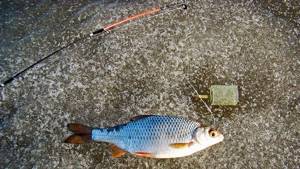
Lure
For an under-ice feeder, it is better to use purchased mixtures from Sensas or other trusted manufacturers. There is no point in messing around with homemade bait, because you won’t need much of the mixture, and in winter, as we remember, it is easier to overfeed the fish. The bait needs to be well moistened so that it does not “dust” when the feeder is immersed in the bottom of the reservoir. When fishing at great depths, soil is added to the bait to make the feeder heavier and speed up its descent in the water column.
Tactics and fishing techniques
When fishing in a familiar body of water, fish resting places, deep holes and undercuts are selected, where holes are drilled. If the reservoir is poorly studied, a hole is drilled in an arbitrary place in order to determine the strength and direction of the current and choose the right feeder. In such conditions, exploratory fishing is more logical, so you will have to drill a lot of holes until the most promising point is found.
Preliminary feeding is no more than three feeders, and fishing is carried out with two rods located at a distance of 2-3 meters from each other. The rod located upstream is equipped with a feeder and a leash. The feeder that is located below is equipped not with a feeder, but with a sinker, so as not to overfeed the fish.
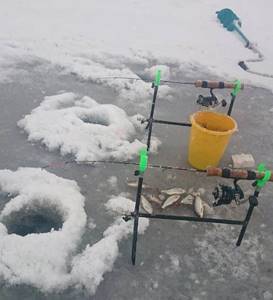
The current carries the bait from the upper feeder to the lower one, and it successfully attracts fish. In practice, it turns out that bites on the feeder with a feeder begin earlier, but after half an hour - an hour, the lower rod begins to register bites from fish approaching the feed. As a result, the angler has bites on both feeders, and even if the fish is minimally active, he will not have to freeze.
Important!!! You should not add animal components to the bait and place several bloodworm larvae on the hook. This way you will not overfeed the fish and force it to react to the proposed bait, which it can quickly swallow.
Best Recipes
Bait recipes for an ice feeder necessarily consist of a base and additives. The base provides stickiness to the composition and gives it a small cloud of food in the water. Most often, the base consists of cereals and various baked goods. But additives should always be crumbly.
Good additives when fishing for bream are cereal grains, pearl barley, peas or canned corn. But peas and millet are the most cherished delicacy for bream.
One of the best recipes has received recognition from most fishermen:
- Half of the bait consists of ground breadcrumbs;
- Bran is added to it in a content of up to 20%;
- about 15% - cake;
- 10% - semolina;
- 10% - crushed rolled oats;
- the rest is bait for winter fishing from the store.
The composition of this bait is so reliable that even on days of bad bite, the fisherman does not return home without a catch. You can easily prepare everything at home and use it in feeders in small portions as needed.
Video from Yulia Lobatsevich
Yulia Lobatsevich goes fishing in winter and summer. She simply could not help but test the ice feeder.
March 2021. Near Minsk there is the “Minsk Sea” (Zaslavskoye Reservoir), popular among fishermen. Fish are caught there all year round. In winter you can excellently catch bream, roach, perch and ruff.
Yulia was fishing for two days, and due to the change in weather, the activity of the fish was very different on these days. On the first day (see below from the beginning of the video until the 10th minute) Julia wanted to compare the effectiveness of float and feeder gear. But the fish simply refused to bite that day. But the float caught only one roach, and with the feeder tackle there were only a couple of unrealized bites and that’s all. On the second day the roach bit much better.
Catching roach in winter with feeder equipment
On this fishing trip I used regular feeder gear with a paternoster and a 10g feeder. The bait is steamed pearl barley, bloodworms and maggots. Winter bait for roaches on this fishing trip – commercial bait for cold water + ground crackers and sunflower seeds.
How to fish in winter with an ice feeder
Only on ice can you find out how active the fish is that day and what its attitude is to the bait. The very first bites and luck allow you to decide on hooks and other elements of feeder fishing.
Hooks
To begin with, hook sizes range from 14 to 18. In this case, you will definitely have to take into account the shape and size of the nozzle. After all, even if the fisherman is in a tent, his hands are cold, and it becomes difficult to handle a very small hook. This applies to putting another bait on it, removing the hook from the fish’s mouth.
When choosing a hook, you need to take into account all of the above factors. A small hook with a short shank will cause a lot of inconvenience, but this can be compensated by a more intense bite. When the entire hook is hidden in the bait, even very cautious fish behave more decisively.
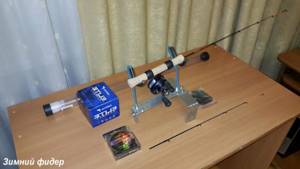
Supporters of winter fishing with a feeder prefer ordinary hooks to any jig.
When choosing hooks, you need to consider both their size and weight. The mass of the hook is directly related to the under-ice current. When the flow is strong, heavier hooks are used, due to which they will be pressed to the bottom and remain in place. If the current is weak, barely noticeable, then you need to use hooks of the lightest design. The final selection of hooks is made during the fishing process by varying their size and weight.
Leash length
Like the hook, the optimal length of the feeder leash is selected during the fishing process. First of all, it is determined by the following factors:
- fish activity on the day of fishing;
- the force of water flow;
- nozzle size;
- the weight of the nozzle.
To begin with, use leashes about 40 centimeters long, but when the bite is active, shorten it, which makes it easier to handle the hook and bait with frozen hands.
The role of the gatekeeper
A winter feeder requires a good rod guard, which is primarily designed to contain the current. When the angle of immersion of the fishing line with the hook is selected correctly, the fisherman feels even the weakest bite.
Most fishermen make the most sensitive guards with their own hands at home. The main thing here is that the fishing line should slide over all parts of the guard without the slightest resistance and move freely. Fishermen with more experience tend to use nods made of spring wire, which is very sensitive to water flow.
Fishing tactics
Tactically correct fishing would begin with finding a fishing spot on the river. Most often, towards the sun, it comes out onto horizontal areas of the bottom adjacent to the edges of deep water.
A very good reference point for starting fishing is a place on the ice where there are many holes drilled in previous days. It was here that there was a good bite, and the fish were already half fed. If there is no bite in such a place, look for concentrations of fish. To do this, drill holes in different places in the reservoir. When you come to the first ice, examine places near coastal thickets or the mouth of a stream on which a reservoir is formed.
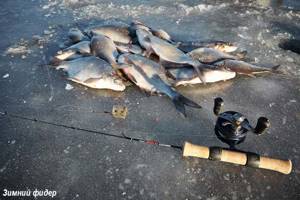
The search for fish in the moving water of the river is conducted somewhat differently. Here, depth measurement primarily plays a role. If the fish does not bite in shallow water, then you should look for it in depth. Just don’t waste a lot of time remaining sitting in the same place without a bite.
It’s a completely different matter if the fisherman has an echo sounder. This modern equipment allows you to see schools of fish and easily determine the most suitable places to catch them.
Fishing technique
The technique of fishing with a feeder is not much different from summer fishing. When the fish is sufficiently fed, it begins to actively take the bait, and this becomes noticeable in the behavior of the guard. Its small twitches are a signal to get ready, but when the guard begins to decisively bend downward, you need to strike.
Video about winter feeder:
In winter, the fish on the hook is not as active as in summer; its jerks and movements to the side are much weaker. But to fish for large specimens, you can’t do without an adjusted clutch.
Only when the head of a large fish appears in the hole can you use a special hook, which is inserted into the gill slit from below, to throw it onto the ice. If the trophy is small and the fishing line is reliable, a little effort with a fishing rod is enough to pull it onto the ice.
How the tackle works
The under-ice feeder works almost exactly the same as the summer version.
The whole process is carried out as follows:
- The equipment is unwound, and then the feeder is attached to it.
- Next, the feeder is filled with pre-prepared treats and lowered into the hole. It is very important to hold the leash.
- After the feeder reaches the bottom, you will need to tighten the fishing line so that the guard bends at the required angle.
The most important thing is not to miss the bite; it will be felt as a frequent twitching of the nod or a sharp weakening of the element. Having made the hook, you can start fishing.
Important! If no bites were noticeable for 15 minutes, then you need to take out the feeder and add a new treat.
There are anglers whose fishing begins with the fact that they actively feed one place where further fishing will be carried out, by throwing several feeders at once. Sometimes this gives results. Although it is better not to practice this in the wilderness.
It should be noted that if you are fishing with several gears at the same time, then the distance between them should be at least one and a half meters in order to avoid overlapping of the line when pulling out the fish.
Many fishermen who are going to fish with a feeder in the winter for the first time do not even know what kind of fish might get caught on it. In fact, the most important thing is that at least someone gets caught. Although it is often possible to catch chub, dace, silver bream, roach, sop, bream and many others. It is interesting that there are fish that are not caught on the feeder, but that actively bite, eating the bait. We are talking about the “snotty” ruff, perches and minnows.
What types of fish to catch
Not all the fish that bite in a given river or reservoir in the summer will be caught on a winter feeder. Main types of fish for winter fishing:
- silver bream;
- dace;
- bream;
- chubs;
- roach;
- crucian carp, carp
In an unfamiliar body of water, you should not independently identify the presence of this or that type of fish. It is enough to talk with the fishermen who visit these places constantly; they are very sociable people for the most part and never make big secrets out of little things.
Sections
In the last week of January, I managed to devote several days to my favorite feeder fishing on the Moscow River. All these glorious days I tried to visit different places, mostly only familiar and important from the point of view of personal memories. The last day, January 24, I wanted to fish in a completely new place, especially since my old fishing comrade from Reutov near Moscow offered to visit a new point with him, where at the beginning of winter he managed to catch good bream. Everything new is interesting to me, especially if I am surrounded by great people. Having happily agreed to the next trip, I tuned in to a new feeder fight. My friend kindly sent me the coordinates of the new place, that’s what I’ll call it so as not to make it accessible to poachers and riggers. He also explained to me in a nutshell about the fishing conditions, working distances and food, which brought him good fish in those waters. The meeting at the point was scheduled for eight in the morning.
In the evening, on the eve of fishing, based on the information thrown into my head, I naturally did a little fishing preparation. Of course, I mixed in feeder bait; For winter fishing in Moskvorechye, all my food is prepared 8-10 hours before the main action. For that particular fishing trip, I prepared a simple and even slightly folk bream composition, which included two kilograms of my original Feeder river bait from the Dunaev company, carefully painted black with Dunaev powder dye. I didn’t add any special additional flavorings to the bait; I believe that in a new, unpressed place, aromatic witchcraft can only do harm. Let the fish begin to interact with natural food first, and then, if anything happens, I always have something to throw into the bait. I also cooked 200 ml of highly purified millet, which I add to the food immediately before fishing, that is, on the shore. In this final combination, the bait turns out to be very inert, purely bottom, having a weak spicy-sweet aroma. Boiled millet, when fishing in a strong current, always lands and makes the bait heavier, plus, this carbohydrate additive itself has long been liked by breams. The only additional additive that I always put in winter feeder baits, especially if the air temperature is negative, is table salt; one large spoon is usually enough for two kilograms of mixture. I do this so that the food mixture does not freeze in the air and, in general, salted food works well for white fish in winter. Also, at home, before fishing, I prepared two dozen leashes of different lengths from fishing lines of different diameters from 0.08 to 0.12 mm with hooks of 14 and 16 numbers, mostly from Owner. I did this because I know the secret, it’s just that in a winter feeder, the determining factor for success is most often the correct supply of bait, so you constantly need to play with the hook and the length of the leash and even its diameter. And whoever is not lazy in this matter, even when it is very cold, most often ends up with a good catch.
Morning came, I was in a hurry. I was there on time and in very high spirits. A meeting with a friend, a short conversation, an exchange of jokes and pleasantries - all this strengthened my intentions in fishing. Inspection of the territory and initial contact with the new point greatly invigorated me. The location was really “trump”: it was a 20-meter walk from the car to the shore, everything was very close and in such a cozy atmosphere under large trees.
The first thing I did was drag my equipment to the shore; by the way, my fishing set for the winter feeder is very simple and portable. It consists of a bag containing a chair, a fish tank, a nozzle table and a landing net head. On your shoulders is a fishing backpack with basic consumables, and in your hands is a case with fishing rods and a bucket of bait.

After arranging and placing the gear accompanying the winter feeder, I took out my new “heavy” Briscola Grumo in a length of 424 and a test of up to 140 g, attached a three-ounce carbon top to it and screwed on a powerful but light-weight reel in size 5500, on the spool of which a rigid monofilament line with a diameter of 0.28 mm is wound. My winter fishing rig is traditional – an asymmetrical loop. In my case, it is removable, made of Pontoon21 Marxman GFC fluorocarbon with a diameter of 0.31 mm.
A friend, seeing my tackle, realized that I would climb into the distant wilds, he warned me in advance that the fish there were not very good, there was an interesting place at 50 m+, but there was an evil edge and a lot of silt at the bottom. He said that all the normal fish were under his feet, at 28-30 m and, so as not to fool around, he sat down and fished in front. As always, I like to swim against the current, so if all the normal ones are catching at my feet, for some reason I have to get into trouble. I promised my colleague that I would fish in the distance for a day, but next time I will definitely fish where he says. In the end, I believed that in winter, lonely fat-bellied breams swam closer to the fairway; I needed one, but big fish. My further actions were related to searching for a point under water, I began to do this with my working feeder with a marker weight weighing 80 g. By the way, I easily reached the fairway with this tackle, but did not find anything interesting there: solid silt and debris at the bottom , but closer at a distance of 54 m I felt a hard edge, which I couldn’t overcome right away - the load, the infection, was stuck. If it weren’t for the long rod and the fishing line with a good breaking load, I would have had to tear it off, but everything worked out. Fishing right behind the edge is not an option; we had to retreat further three meters. This place was a classic bream place, at least if I were a bream, I would definitely swim there.
The current at the working distance allowed me to fish there with a metal feeder weighing 80 g; for this I chose a large “cage” from Browning, which could hold up to 100 g of bait at a time. The large feeding device allowed me to quickly cover the fish clearing with bait, and then fish in long wait mode.
After measurements and all the calculations, I finalized my bait: I added millet and 100 ml of maggots and the same amount of small moths to it. I mixed the whole thing thoroughly and then started feeding the point. The starting feeding consisted of 10 large feeders. By the way, I intended to use large feeders for all the fishing. The next step involves attaching the leash to the rig; I started with a 90 cm leash made from fishing line with a diameter of 0.10 mm with a number 14 hook. A friend said that only bloodworms in the form of a bait work here; I plant two fat bloodworms and launch the equipment into the water. The first goal is to get a bite. Usually, for the first hour I target every movement of the tip, take large intervals between recasts and don’t take my eyes off the whip. The first bite, no matter who it is, is evidence that the fish has arrived at the point or has been there all along.
The bite occurred only in the 20th minute from the moment the bait hit the water, and before that I had already managed to re-throw the tackle three times. A short rattle of the whip, I lift the form and don’t feel the fish. I reel it in and see a ruff on the hook, such a large, snouty one. The first one is there, he swallowed it down to the tomato, he seems to be dead.
The second bite in five minutes for one bloodworm. Despite the fact that the equipment is self-hooking, the fish did not land. I change the leash, set it to 120 cm with a red hook of number 16, the attachment is two bloodworms. I cast and after two minutes I see a normal bite, definitely not a ruff. I hook it - there it is, the dear one is sitting, I bring the first bream to the landing net by 200 grams. He is somehow very thin. Cast and silence for ten minutes. The next fish is again a ruff, smaller than the first.
Something had to be done. My friend, while I was thinking and staring at the whip, said that there were no fish there and before it was too late, he suggested that I switch to fishing at his distance, by that time he had already caught two fish, one of which was very good, about 500 grams. I didn’t give up, after all, if it’s here, it’s floating there too. And, as in response, I again got a bite from a small bream at 150 g. Then I began to experiment with aroma: sprinkle different variations of attractive dips onto the bait. This didn’t really bring any results - three more small white bream in an hour and a couple of ruffs. My next action was due to the fact that I quickly threw five more feeders with food to the point, then shortened the leash to 60 cm, increased the nozzle and began to wait for 10 minutes. In half an hour, this brought me three more bream, the fish, as if under a spell, was caught only once every ten minutes. Yes, I didn’t say, all the fish were caught clearly from the bottom, this was evidenced by the fact that all the notches were clearly on the lower lip or the hook flew deep into the fish’s mouth and clung there to the side or bottom of the throat.
If the fish bites and eats from the bottom, perhaps it simply does not have enough food. After all, the flock begins to stand at a point only in the presence of a good food signal; maybe you just need to give in to the aromas, the very one that was pecked at more often. By the way, by that time all the white bream were taken on a bait treated with a dip with the smell of “Robin Red”, which contains a red dye.
My friend no longer asks me to move to another distance, he catches it little by little, but it seems that he himself became interested in what I could conjure there.
I decide to experiment. I pour some food into a separate container, treat it with a working dip and quickly transfer this entire volume to the fishing point. Almost immediately a movement begins, which brings eight fish over the next hour - three ruff and five white bream, slightly larger than the first. All fish were taken strictly for two bloodworms. Then there’s a pause, a long one – about twenty minutes, and on one of the recasts I find a sucked bloodworm. I don’t know why, but my brain makes me lengthen the leash and reduce its diameter to 0.08 mm, I also put a smaller hook, number 18, on which I put two bloodworms and spray it with working dip. Cast, wait about twelve minutes and get a clear bite with shooting. I raise the form and feel a strong characteristic jerk, then a second one. It’s definitely a bream and a big one, I turn the reel and feel the descent. Yes... I felt offended... I pulled it up and saw that the leash had broken where the loop was. I was given a chance, but I blew it. Yes, but in the end, the fish should have a chance, nevertheless, I forced him to swim.
My next action is to massively feed the point with bait flavored with working dip. I placed feeder 20 at the point, the food was almost finished. Then a long wait for the first bites after the descent. The fish returned and I took a few more bream, but not large ones. After each fish I made three feeding casts at a pace, but the situation did not change much. Until, after two fish in a row, there was a pause again, I did not change anything in the leash, but simply enlarged the bait to five bloodworms and began to wait for a bite. Fifteen minutes passed, of course, I wanted to pull it out, but I waited. I even moved about twenty meters away from the gear and began to look at the top from afar. Outwardly it looked idiotic. Another five minutes passed and I saw a very distinct bream bite: the tip bent sharply, and then straightened, and so on twice. I run up to the tackle, lift it and feel the presence of a normal fish at the other end. I'm in no hurry, but I'm a little afraid. I don't want to go. I work quietly and carefully. Three minutes later there was a fish worth 700 grams in my landing net. The job was done, I’m satisfied. I decide to stop fishing.
I take out the fish tank - exactly 16 fish, not enough, of course, but valuable. Next time, if I find myself in this place and fish at such a distance, I will definitely put half a bucket of food at the start point. Fish in a new place definitely respond to a good amount of food on the bottom, but, again, you need to check everything.

Which echo sounder to choose
Echo sounders for ice fishing have their own characteristics. They must have good scanning parameters at shallow depths, be compact and not afraid of low temperatures. It is better to buy a product from a company that specializes in equipment for winter fishing. Many fishermen prefer Praktik echo sounders for feeder fishing.
From the shore, wireless echo sounders are usually used, when the signal is transmitted from the sensor to the monitor by radio waves, but for feeder fishing, a float version with a wire is quite suitable.
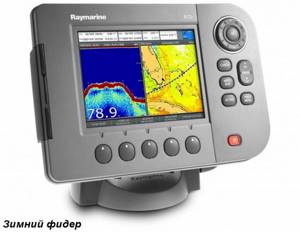
Important points in choosing an echo sounder are the size of the reservoir and its average depth.
